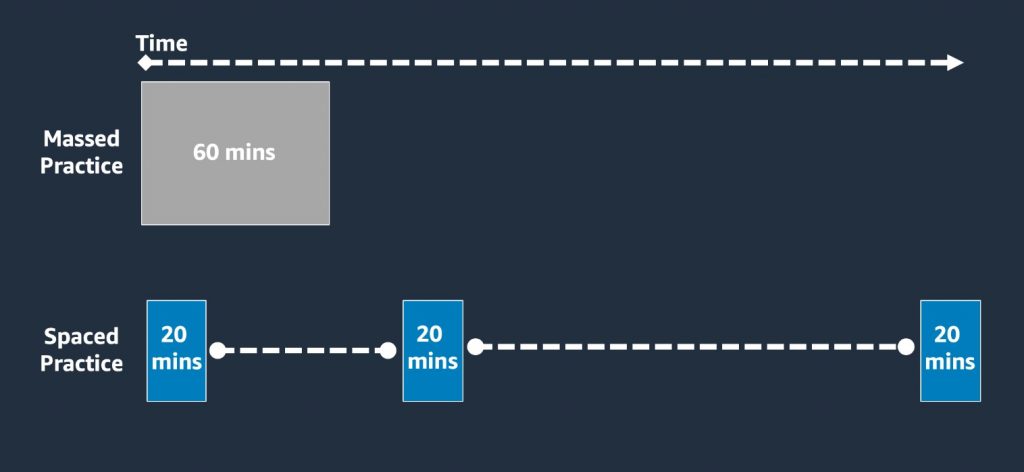AWS Training and Certification Blog
Cognitive Science Post 2: Using Spaced Practice to increase knowledge retention
This is the second of a series of posts on how you can use principles from the cognitive sciences to enhance your learning of the AWS Cloud.
In the first post, we discussed the importance of retrieval practice for long-term learning. There are hundreds of AWS services and features that you need to stay on top of. As a more effective way of learning all of this, you have to do more than just passively take in information by, say, watching videos and reading documentation. You also need to actively recall or retrieve the information you’re learning by testing yourself through activities like quizzing, note card study, and hands-on activities like labs.
But with our busy schedules, many of us don’t have the time to constantly challenge ourselves with retrieval practice. This is where the principle of Spaced Practice comes in handy.
Spaced Practice, or spacing, is the concept of distributing your learning over a period of time at increasing intervals.

Say you want to review some note cards you’ve created that align to a video you watched earlier this week on Amazon S3. The note cards will take you about 60 minutes to get through. The spacing principle tells us that distributing this practice over multiple learning events is much more effective for long-term learning than doing all of the practice in one large chunk.
The key behind spacing is to hold off on your retrieval practice until you’re just about on the brink of forgetting the information you’re trying to recall. This sweet spot will be different for all of us.
Regardless, information we’re learning needs time to consolidate into the parts of our brain associated with long-term memory. Delaying (or spacing) retrieval of that information helps ensure you’re strengthening the neural networks associated with the long-term memory of that information. Retrieval Practice that is not spaced out does not account for this necessary consolidation of memory and ends up being more a validation of your short-term memory.

Spaced retrieval practice activates memory traces after they’ve consolidated into areas of the brain that store long-term memory. The Medial temporal structure stores short term memories. The Neocortex stores long-term memories.
Let’s go back to our example of the Amazon S3 video. If you watch that video and then immediately quiz yourself on what you just heard, you’re pulling the information to answer those questions from your shorter-term memory store. There hasn’t been enough time for the information to be consolidated into long-term memory.

Retrieval Practice immediately after a study session or presentation initiates the short-term memory.
Spaced Practice proposes that you delay (or space) quizzing yourself by a few hours or even a couple of days. At this point the information has had time to consolidate into your longer-term memory. It’ll be harder to answer the questions now, but in the long run it will have a greater impact on your learning.

Retrieval Practice when there is a delay or spacing after a study session or presentation activates the long-term memory.
So, how do you leverage Spaced Practice for your own learning of the AWS Cloud?
Here are some ideas:
- Stop cramming and break up your learning into smaller chunks. Studying for a week straight might feel like it’s working in the short-term, but for long-term learning, it’s less effective. Instead, take advantage of hundreds of AWS trainings, many of which are digital, bite-sized courses that help you more easily space out your learning over a period of, say, weeks opposed to just a few days.
- Choose a learning path and create your own spaced learning schedule. Our learning paths are comprised of a progression of courses and exams that you can follow to help advance your AWS Cloud skills. Once you find the learning path that is right for you, create your own schedule that spaces out your learning over a period of time opposed to cramming your learning into only a couple large blocks.
- Revisit important topics and test yourself comprehensively. Don’t rely on just hearing or seeing something once and then expect it to stick. For long-term learning to occur you have to revisit topics many different times. And as mentioned in my earlier blog post, don’t just revisit that information passively. Leverage Retrieval Practice techniques by quizzing yourself or completing labs that require recall of key information. One specific tip is to ensure your retrieval practice is constantly building on what you’ve learned in the past. For instance, don’t just watch a video on Amazon S3; test yourself on some core topics related to that video, and then move on – never to ask yourself those questions again. Instead, continue to test yourself on the Amazon S3 topics even as you move on to other services. Don’t take them out of your retrieval practice rotation until you’ve confidently answered the questions correctly at least three times.
The catch with these and other strategies for implementing Spaced Practice is that they can make learning feel more challenging. But understanding that long-term learning is hard can help ease the pain and make it more likely that you apply this research- and science-backed principle into your own study of the AWS Cloud. In the final post of this series, I’ll explain how Elaboration will aid your learning. Stay tuned!